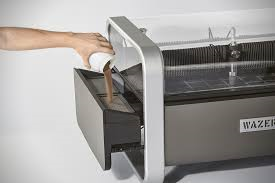
Breaking News
 $26M Frozen on Blockchain - With One Click
$26M Frozen on Blockchain - With One Click
 Italy are on national strike shutdown rejecting digital enslavement...
Italy are on national strike shutdown rejecting digital enslavement...
 The following U.S. states are currently using the rebranded "Reporty Homeland Security" so
The following U.S. states are currently using the rebranded "Reporty Homeland Security" so
 NATO Chief Urges Europe To Prepare For Long-Term World War With Russia, China, Iran & North Korea
NATO Chief Urges Europe To Prepare For Long-Term World War With Russia, China, Iran & North Korea
Top Tech News
 HUGE 32kWh LiFePO4 DIY Battery w/ 628Ah Cells! 90 Minute Build
HUGE 32kWh LiFePO4 DIY Battery w/ 628Ah Cells! 90 Minute Build
 What Has Bitcoin Become 17 Years After Satoshi Nakamoto Published The Whitepaper?
What Has Bitcoin Become 17 Years After Satoshi Nakamoto Published The Whitepaper?
 Japan just injected artificial blood into a human. No blood type needed. No refrigeration.
Japan just injected artificial blood into a human. No blood type needed. No refrigeration.
 The 6 Best LLM Tools To Run Models Locally
The 6 Best LLM Tools To Run Models Locally
 Testing My First Sodium-Ion Solar Battery
Testing My First Sodium-Ion Solar Battery
 A man once paralyzed from the waist down now stands on his own, not with machines or wires,...
A man once paralyzed from the waist down now stands on his own, not with machines or wires,...
 Review: Thumb-sized thermal camera turns your phone into a smart tool
Review: Thumb-sized thermal camera turns your phone into a smart tool
 Army To Bring Nuclear Microreactors To Its Bases By 2028
Army To Bring Nuclear Microreactors To Its Bases By 2028
 Nissan Says It's On Track For Solid-State Batteries That Double EV Range By 2028
Nissan Says It's On Track For Solid-State Batteries That Double EV Range By 2028
Cut Anything With Water

Ever wanted to cut an outline of China out of a china plate, or to cut a wee knife out of a larger knife blade? A new tool lets you easily and cheaply cut just about any shape out of any material—using the power of water.
A group of engineers from the University of Pennsylvania created the world's first affordable desktop waterjet cutter as their senior design project. This water "laser," named (of course) WAZER, uses a pressurized blend of tap water and sand to blast through practically any material and cut precise, customized shapes.
How can water cut through tough materials like steel, ceramic tile, and titanium? First, water and garnet sand are combined into a slurry mixture. Then they're squeezed into a narrow stream with a width of 1.5 millimeters—that's roughly the height of a penny. This abrasive jet shoots out of the spout fast enough to slam through any object in its path.
Moving at anywhere from half an inch to a foot per minute (depending on the material), the jet traces digital designs created in software programs such as Solidworks and Adobe Illustrator. As WAZER follows this pre-programmed path, it filters the excess sand and waste materials into built-in canisters and empties the used water into standard drainage systems.

 Carbon based computers that run on iron
Carbon based computers that run on iron

